Introduction
Aircraft are designed to transport people or cargo from one airport to another. They come in different sizes, shapes, and designs. They are huge, heavy metal birds that effortlessly lift into the air, fly to their destination, and land safely. An aircraft has many parts with interesting functions.
Aircraft A-380 has a length of 73 meters and a height of 24 meters. It can comfortably accommodate more than 500 passengers. Its maximum takeoff weight is 560 tons. Imagine the engineering and science that makes such a massive aircraft fly smoothly and safely in the air.
An aircraft has several parts assembled. And the pilot has different controls for maneuvering it on land and in the air. Do you want to know the parts of an aircraft and their functions? Then this article is for you. Let us start! Parts of an airplane and their functions!
The major parts of an aircraft and their functions
The following are the major parts of an airplane:
- Fuselage
- Fuel-carrying space in an aircraft
- Cockpit
- Wings
- Leading edge, trailing edge, wing root, and wing tip
- Aileron
- Flaps
- Slats
- Spoilers
- Winglets
- Empennage
- Horizontal Stabilizer
- Vertical Stabilizer
- Elevators
- Rudder
- Control surfaces
- Primary control surfaces
- Secondary control surfaces
- Aircraft engine
- Landing gear or undercarriage
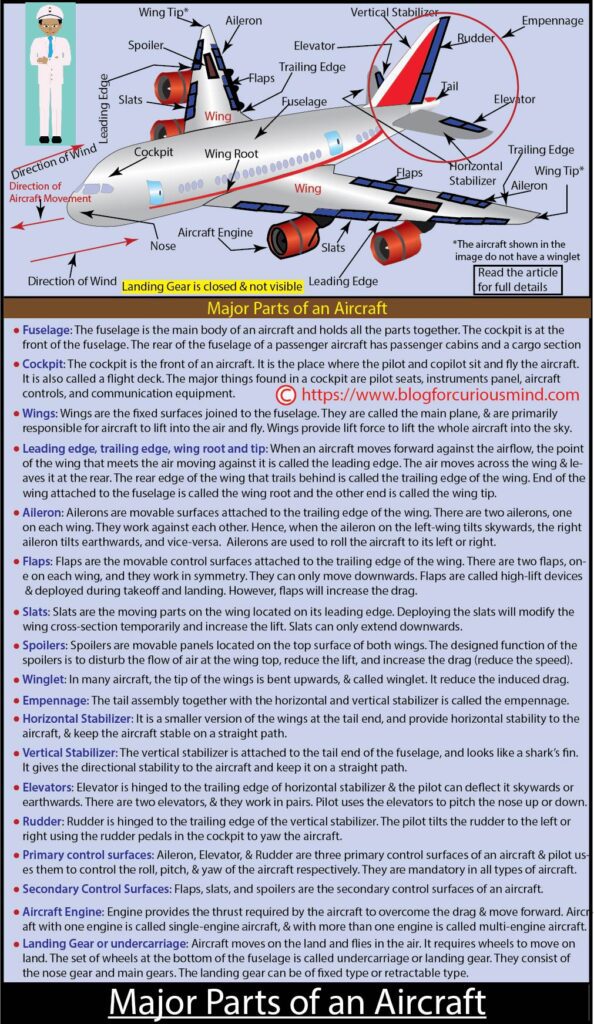
Fuselage
The fuselage is the main body of an aircraft and holds all the parts together. It is the largest structure of the aircraft and has a tubular construction. An aircraft can be built to carry people or cargo. Accordingly, it is called a passenger aircraft and cargo aircraft respectively.
The cockpit is at the front of the fuselage. The rear of the fuselage of a passenger aircraft has passenger cabins and a cargo section. Passenger cabins accommodate the passengers and crew. The cargo section of a large passenger aircraft is normally located at the lower portion of the fuselage. It accommodates the cargo belonging to the passengers and crew.
Cargo aircraft are designed solely for transporting cargo. They have the cockpit at the front of the fuselage, and the remaining fuselage is designed to hold the cargo.
The shape of the fuselage can vary based on its size, design, and manufacturer.
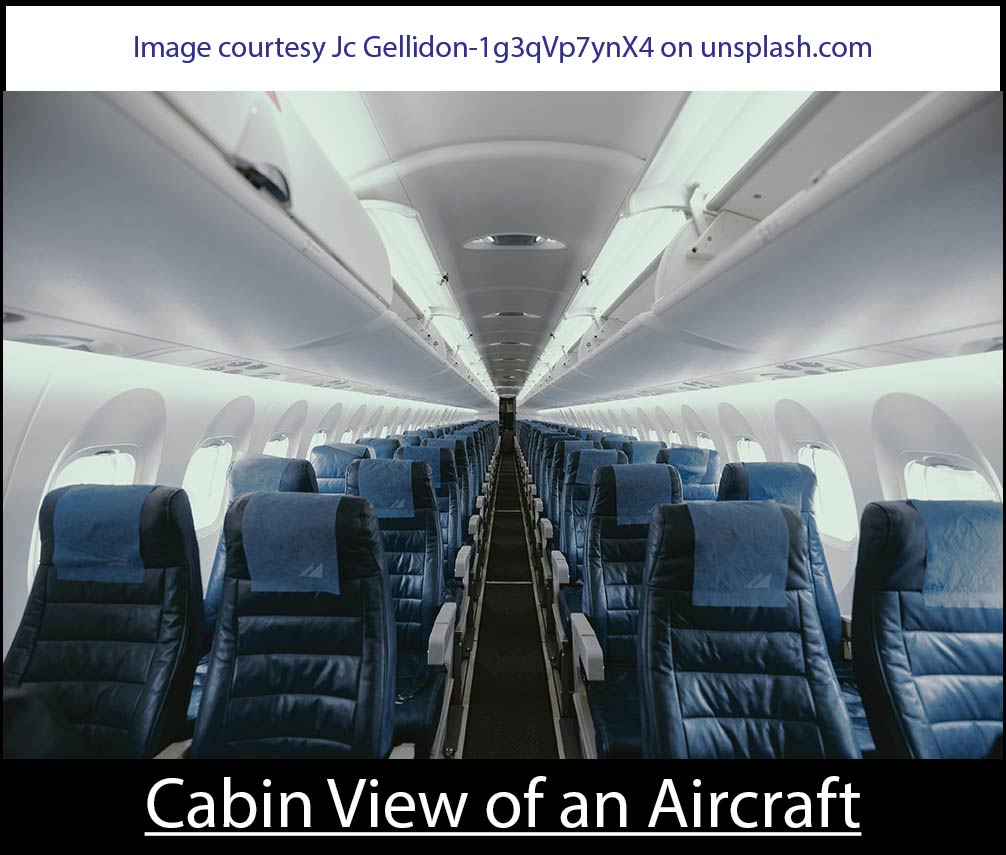
Fuel-carrying space in an aircraft
Aircraft use specially designed fuel for aircraft engines called ‘aviation fuel.’ It is interesting to know that the wings of an aircraft serve as a fuel tank. This ensures efficient utilization of the wing space. However, some aircraft may carry additional fuel in the fuselage also.
Cockpit
The cockpit is the front of an aircraft. It is the place where the pilot and copilot sit and fly the aircraft. It is also called a flight deck. The major things found in a cockpit are:
- Two adjustable seats to accommodate the pilot and copilot. Long haul aircraft may have additional seats to accommodate the second crew of pilot and copilot.
- Instrument panel of meters and gauges including altimeter (showing the altitude of flight), speed display meter, navigation information, etc.
- Overhead panels and controls for electrical, hydraulic, fuel, and other controls.
- Yoke: A yoke resembles a car steering wheel. It can be rotated as well as pushed and pulled. The pilot rotates the yoke clockwise and counterclockwise to control the ailerons and push or pull it to control the elevators. In some aircraft a side stick replaces the yoke, and does its functions.
- Rudder pedals: There are two rudder pedals, left and right on the floor of the cockpit. These pedals are used for controlling the rudder. Rudder pedals are also used during taxiing on the runway.
- Throttle: The pilot uses the throttle to regulate the engine output and speed of the aircraft.
- Communication equipment: Pilots use this to communicate with ground control towers.
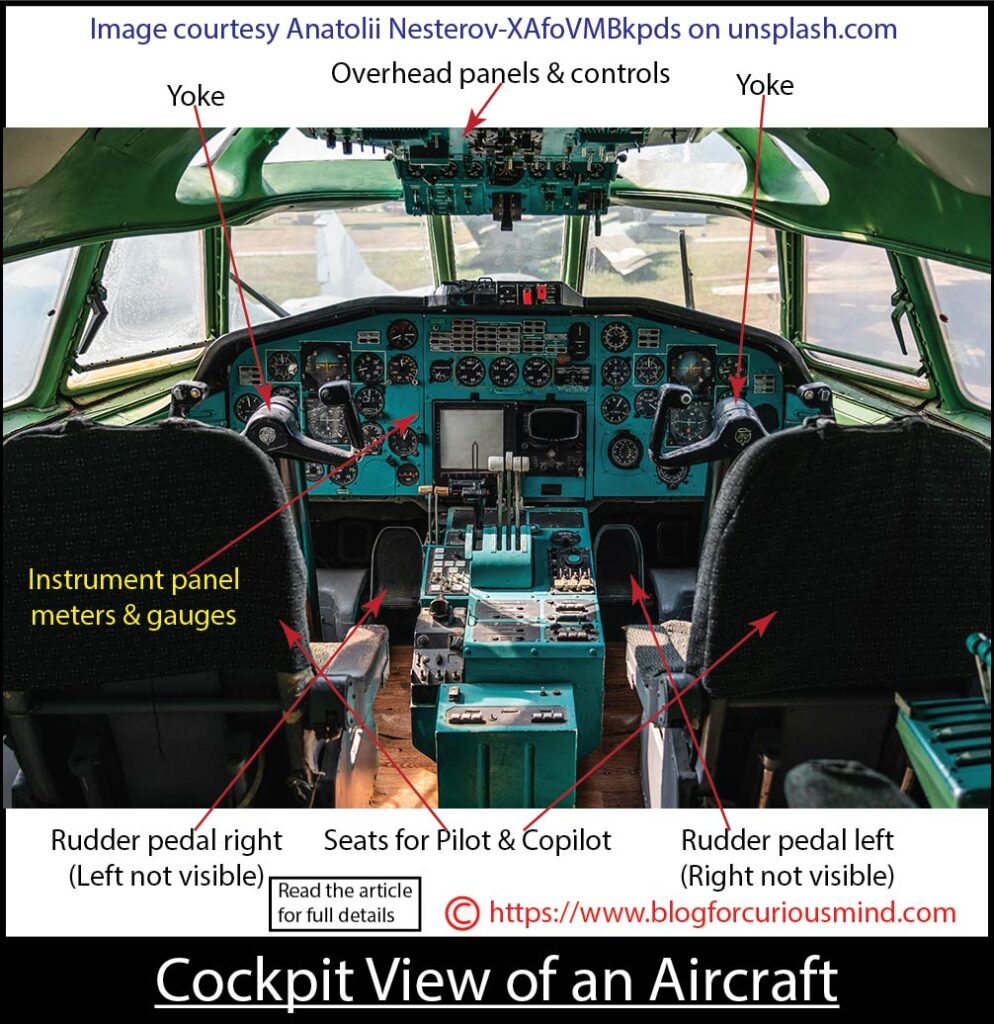
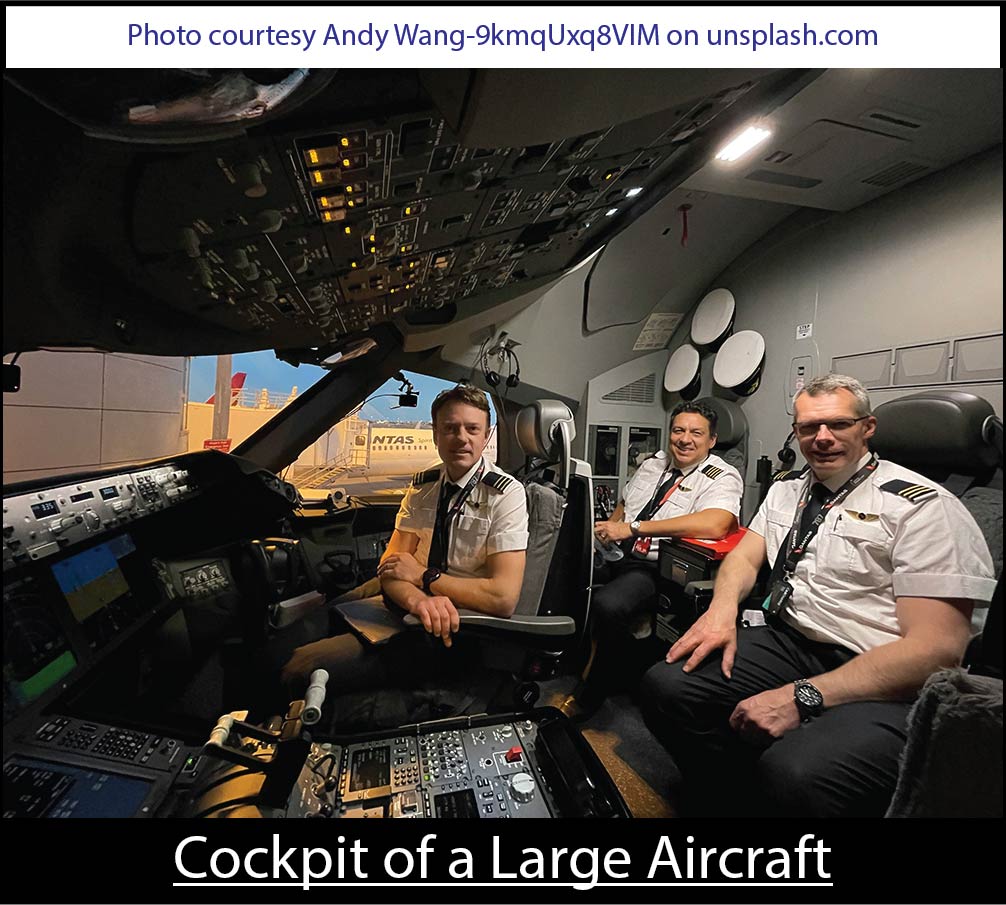
Wings
Wings are the fixed surfaces joined to the fuselage and called the main plane. They are primarily responsible for an aircraft to lift into the air and fly. They provide the lift force to lift the aircraft into the sky. The wings come in many shapes and designs based on their size and the manufacturer.
There are aircraft with their wings attached to the upper end of the fuselage, called a high wing design. And, there are aircraft with their wings attached to the bottom end of the fuselage, called low wing design.

The aircraft wing has an airfoil cross-section that utilizes the air moving on its upper and lower sides to generate the lift. It provides the necessary lift to the aircraft wings and keeps the aircraft flying. The wings can generate lift only when the aircraft moves forward in air.
Parts of the wing
The wings of an aircraft have the following parts.
- Leading edge, trailing edge, wing root, and wing tip
- Ailerons
- Flaps
- Slats
- Spoilers
- Winglets
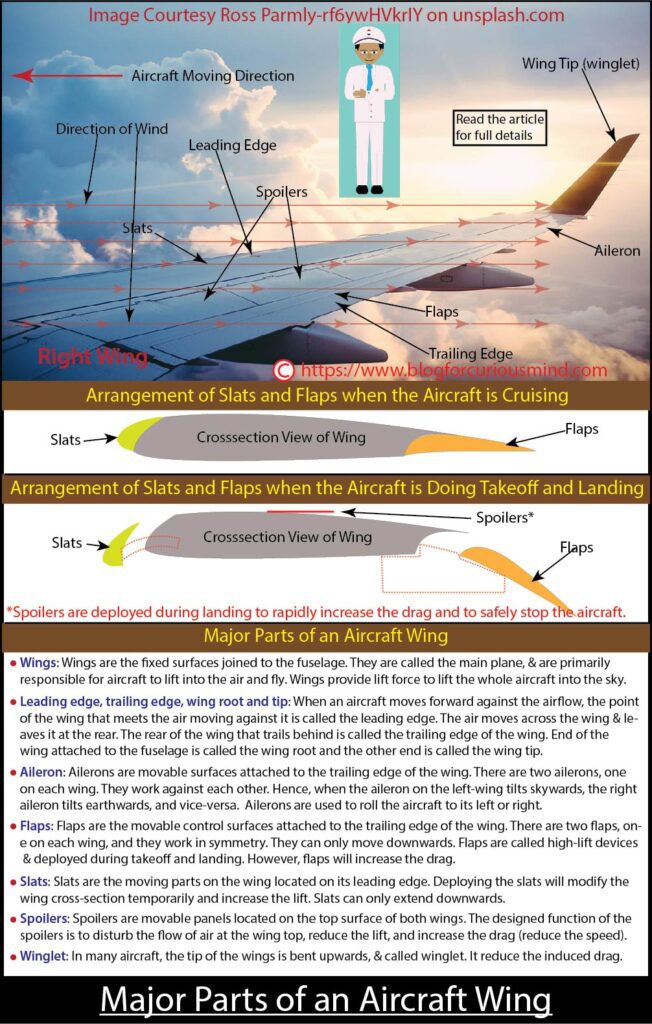
Leading edge, trailing edge, wing root, and wing tip
When an aircraft moves forward against the airflow, the point of the wing that meets the air moving against it is called the leading edge. The air moves across the wing and leaves it at the rear. The rear edge of the wing that trails behind is called the trailing edge of the wing.
One end of the wing that is attached to the fuselage is called the wing root and the other end of the wing is called the wing tip.
Aileron
Ailerons are the movable surfaces attached to the trailing edge of the wing towards the wing tip. There are two ailerons, one on each wing. They are used to roll the aircraft to its left or right.
The two ailerons work against each other. Hence, when the aileron on the left-wing tilts skywards, the right aileron tilts earthwards, and vice-versa. The pilot controls the ailerons from the cockpit and uses them during turning.
Ailerons are one of the three primary control surfaces of an aircraft. The other two primary control surfaces are the elevators and rudder.
You may read the article ‘What are the three axes of flight’ to know more about the three primary control surfaces and how the pilot uses them for roll, pitch, and yaw.
Flaps
Flaps are the movable control surfaces attached to the trailing edge of the wing towards the wing root. There are two flaps, one on each wing. Unlike the ailerons, the flaps on both wings work in symmetry. The flaps can only move downwards. The pilot can deploy the flap in angular increments.
Flaps are called high-lift devices capable of increasing the lift of aircraft wings at a given airspeed. They help reduce the minimum speed at which an aircraft can be flown safely. However, flaps will increase the drag, so, they are deployed only when needed.
Flaps increase the capability of the wings to fly the aircraft at lower speeds, typically during takeoff and landing.

Slats
Slats are the moving parts on the wing (like flaps) located on its leading edge. Deploying the slats will modify the wing cross-section temporarily and increase the lift.
Slats provide higher lift at low speeds typically required during takeoff, initial climb, and landing. They help maneuver the aircraft at low speeds.
Like flaps, slats are classified as high-lift devices. Slats can only extend downwards. The pilot can deploy the slats in angular increments. As the slat moves down, it increases the wing camber, and hence lift is increased.
Spoilers
Spoilers are movable panels located on the top surface of both wings. The designed function of the spoilers is to disturb the flow of air at the wing top, reduce the lift, and increase the drag (reduce the speed). Deploying the spoilers will reduce the lift and allow the aircraft to descend or lose altitude.
Spoilers are also named lift spoiler or lift dumper since that is what they do. The pilot can use the spoilers to intentionally reduce the lift of the wings in a controlled manner.
Spoilers can only be deployed upwards and brought back to its original position. They are deployed during landing to rapidly increase the drag and to safely stop the aircraft.
You may view this YouTube video on flaps and spoilers, and this YouTube video on flaps, slats, and spoilers.
Winglet
In many aircraft, the tip of the wings is bent upwards. The bent tip is called a winglet. It helps reduce the induced drag. Winglets enhance the efficiency of an aircraft.
Empennage
The tail assembly together with the horizontal and vertical stabilizer is called the empennage. The function of the aircraft’s tail assembly is to provide stability while flying and to keep the aircraft on its course.
The empennage consists of:
- Horizontal Stabilizer
- Vertical stabilizer
- Elevators
- Rudder
Horizontal stabilizer
In most aircraft designs, you will find a smaller version of the wings at the tail end, called horizontal stabilizers. They provide horizontal stability to the aircraft. They are attached to the fuselage and do not move. They keep the aircraft stable on a straight path and prevent the pitching of its nose.
Vertical stabilizer
The vertical stabilizer is attached to the tail end of the fuselage and looks like a shark’s fin. It gives the directional stability to the aircraft and keep it on a straight path. It helps keep the aircraft’s nose from veering side to side.
Elevators
The elevator is hinged to the trailing edge of the horizontal stabilizer and the pilot can deflect it skywards or earthwards. There are two elevators, left and right, and they work in pairs. The pilot uses the elevators to pitch the nose up during climbing and pitch the nose down during descending.
When the nose is in pitched-up condition, the wings generate higher lift due to the changed angle of attack. This is used during takeoff.
Rudder
The rudder is a moving surface hinged to the trailing edge of the vertical stabilizer. The pilot tilts the rudder to the left or right using the rudder pedals in the cockpit. It functions like the rudder of a boat and helps the aircraft to change its direction (yaw). However, the pilot uses ailerons in combination with a rudder for the smooth turning of the aircraft.
Control surfaces
The aircraft climbs into the air, descends to the ground, and steers to its left and right while flying. The pilot makes all these maneuvers using the parts of the aircraft called ‘control surfaces.’
There are two types of control surfaces:
- Primary control surfaces
- Secondary control surfaces
Primary control surfaces
The Aileron, Elevator, and Rudder are the three primary control surfaces of an airplane and the pilot uses them to control the roll, pitch, and yaw of the aircraft respectively. They are mandatory in all types of aircraft.
You may read the article ‘What are the three axes of flight’ to know more about the three primary control surfaces and how the pilot uses them for roll, pitch, and yaw.
Secondary control surfaces
Flaps, slats, and spoilers are the secondary control surfaces of an aircraft. However, they are not mandatory on all aircraft. They improve the performance characteristics of an aircraft and assist the pilot in flying it smoothly.
Aircraft engine
The engine provides the thrust required by the aircraft to overcome the drag and move forward.
An aircraft can have one or more engines. Accordingly, they are called single-engine aircraft and multi-engine aircraft.
In single-engine aircraft, the engine is normally mounted inside the forward part of the fuselage. In multi-engine aircrafts, the engine may be mounted to the wings, or to the upper sides of the fuselage.
An aircraft engine can be of two types:
- Piston engine
- Jet or turbine engine
A piston engine is a reciprocating internal combustion engine, like the engine in a car. It uses the energy produced by the combustion of compressed air-fuel mix in the engine cylinder to rotate a propeller. The rotating propeller blades produce the thrust required to move the aircraft forward.
Piston engines with propellers are normally found on smaller aircraft. A small two-seater aircraft can have one propeller engine at its nose. A slightly bigger aircraft can have two propeller engines, one each mounted to the wing.
The turbine engine has blades built into it called turbine blades. It burns a mix of compressed air and fuel, and the high-speed jet exhausted at the rear of the engine produces the thrust for moving the aircraft forward. Newton’s third law of motion says for every action there is an equal and opposite reaction. So, the higher the velocity of the jet exhaust, the higher is the forward thrust to the aircraft.
You may watch this YouTube video on working of a jet engine.
Landing gear or undercarriage
An aircraft moves on the land and flies in the air. It requires wheels to move on the land. The set of wheels at the bottom of the fuselage is called undercarriage or landing gear.
They consist of the nose gear (set of wheels under the aircraft nose) and main gears (set of two wheels at the bottom of the fuselage, near the wings). This type of aircraft wheel design is called tricycle design and is found in most aircraft.
However, there are undercarriage designs that have a tail wheel instead of a nose wheel.
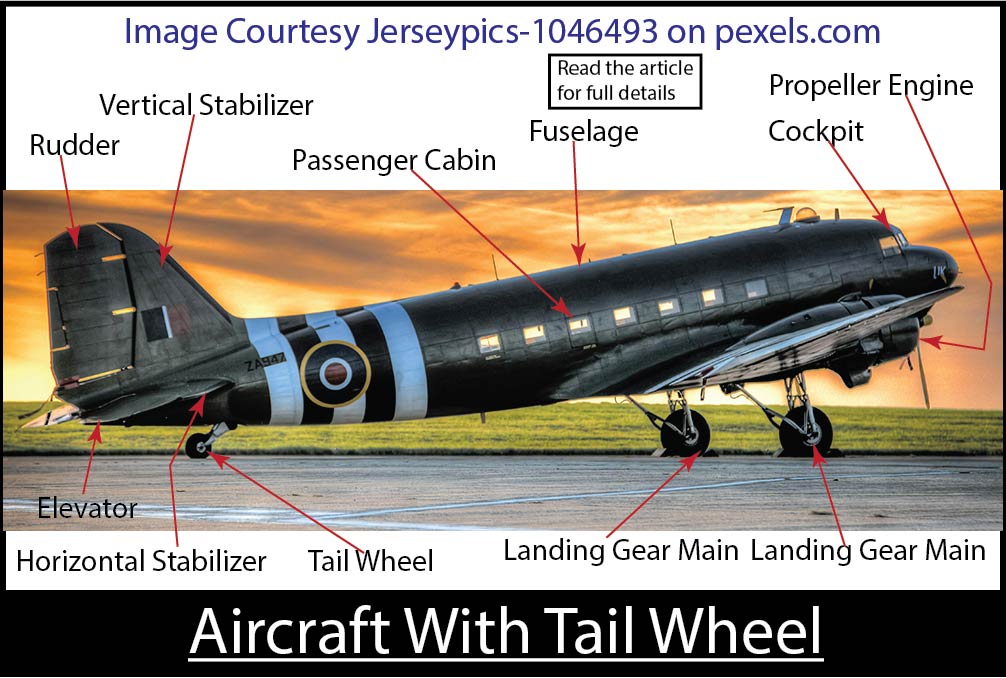
The landing gear can be of fixed type or retractable type. Smaller aircraft normally have fixed-type landing gear. And, larger aircraft have retractable type landing gear.
In fixed type, the landing gear is open throughout the flight. In retractable design, the pilot retracts the wheels into the fuselage after the aircraft climbs into the air and drops them during landing. This design reduces the air resistance and increases the speed and efficiency of the aircraft.
Conclusion
In the preceding paragraphs, we had a detailed discussion of the major parts of an aircraft and how they work. When you fly next time, book a window seat at the wings, and observe how the moving parts of the wing work during the flight. Hope this article was useful to you.
You may read the article ‘How an airplane flies?’
You may watch this YouTube video on parts of an aircraft.
Caution: The objective of this article is only educational. If you are interested in learning how to fly an aircraft, please enroll with a Flying Institute near you for formal training.
Note: Edits with supporting data are welcome!
